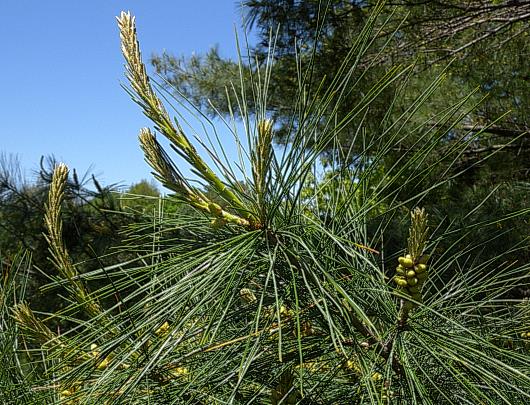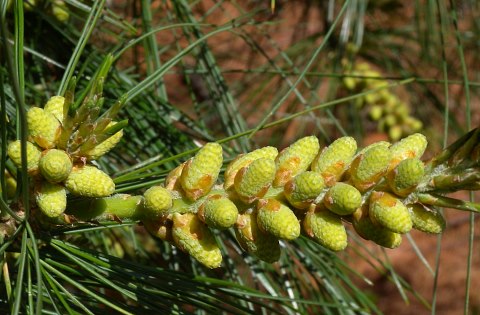Description: This coniferous tree is typically 80-120' at maturity. It has an unbranched central trunk up to 4' in diameter and whorls of lateral branches that are more or less horizontal. The crown of the tree is conical, becoming more flat-topped and irregular with age. The bark of the trunk is dark gray and rough; it is fissured into irregular square plates. The bark of smaller branches is gray and smooth with small lenticels. There are 2 types of needles: new growth on the tips of twigs have green needles up to 1" long that are appressed to ascending. More mature twigs have green to blue-green needles 3-5" long that are arranged in clusters of 5 (although some needles may be missing from a cluster). These longer needles are widely spreading, somewhat soft, and slightly twisted; they usually persist for 2 years, after which they turn brown and fall off.

Eastern White Pine is monoecious, bearing separate pollen (male) and seed (female) cones on the same tree. The seed cones are wind-pollinated, with the pollen traveling up to 200-700 ft. The pollen cones occur in spike-like clusters up to 2" long; these clusters are located behind the new growth on the tips of twigs. Each pollen cone is yellow, short-ovoid in shape, and about ½" long. Young seed cones are small and pink; they are arranged together in small clusters. At maturity, the seed cones are 4-8" long, ellipsoid-cylindric, and grayish brown; they droop downward on short stalks up to 1" long. The woody scales of mature seed cones lack prickles. At the base of each scale on a seed cone, there are two seeds. The body of each seed is about ¼" (5-6 mm.) long, ellipsoid in shape, and orange-brown; attached to the seed is a pale brown wing about ¾" in length. The root system is woody, abundantly branched, and somewhat shallow; there is no taproot. This tree reproduces by reseeding itself, sometimes forming extensive colonies.

Cultivation: White Pine prefers full to partial sunlight, well-drained conditions (moist to dry-mesic), and a rather loose soil that lacks clay. It adapts particularly well to soil containing sand or sandy loam with a pH of 4.0–7.0. Highly alkaline soil is not tolerated. White Pine is vulnerable to White Pine Blister Rust (an introduced disease), intense heat and drought, strong winds, and air pollution. It is fast-growing and widely cultivated, preferring a cool and humid climate.
Range & Habitat: White Pine is native to northern Illinois, where original stands of this pine are uncommon (see Distribution Map). However, this pine has been introduced to forested areas throughout the state. Illinois lies along the southern edge of the range for this boreal species, which is found primarily around the Great Lakes, the Northeast, southern Canada, and parts of the Appalachian Mountains. Habitats include upland woodlands, sandy woodlands, and forested bogs. This last habitat is less typical than the others.
Faunal Associations: Insects that feed destructively on White Pine and other pine trees (Pinus spp.) include wood-boring larvae of long-horned beetles, larvae of bark beetles, larvae and adults of weevils, plant bugs, stink bugs, aphids (mostly Cinara spp.), spittlebugs, armored scales, mealybugs, larvae of conifer sawflies, larvae of web-spinning sawflies, larvae of dagger-tail sawflies, larvae of horntail wasps, larvae of Geometer moths, larvae of owlet moths, larvae of snout moths, larvae of Tortrix moths, and larvae of Sphinx moths (Lapara spp.). Insects that prefer to feed on White Pine include the White Pine Weevil (Pissodes strobi), Pine Leaf Adelgid (Pineus pinifoliae), two other Adelgid aphids (Pineus floccus, Pineus strobi), an aphid (Prociphilus crataegistrobi), Pine Spittlebug (Aphrophora cribata), a leafhopper (Empoasca coccinea), larvae of the White Pine Sawfly (Neodiprion pinetum), larvae of the Introduced Pine Sawfly (Diprion similis), and larvae of two moths, the White Pine Angle (Macaria pinistrobata) and White Pine Cone Borer Moth (Eucosma tocullionana). See the Insect Table for a more complete list of these insects. Mammals also use White Pine and other pine trees as a source of food. This includes the White-tailed Deer (twigs, foliage), Cottontail Rabbit (small saplings), North American Porcupine (bark, wood), White-footed Mouse (seeds), Eastern Gray Squirrel (seeds), Fox Squirrel (seeds), and American Red Squirrel (seeds); see Martin et al. (1951/1961), Haugen (1942), and Ludewig & Bowyer (1985). Bird species that eat the seeds of White Pine include the Wood Duck, Northern Cardinal, Chipping Sparrow, Evening Grosbeak, Pine Siskin, Common Grackle, Bobwhite Quail, Wild Turkey, Ring-necked Pheasant, Black-capped Chickadee, Pileated Woodpecker, and White-breasted Nuthatch. The Yellow-bellied Sapsucker drills holes in the wood to suck the sap (see Bird Table for more complete information). Many birds also use White Pine for protective cover and nesting habitat. This includes such warbler species as the Hooded Warbler, Yellow-rumped Warbler, Yellow-throated Warbler, Blackburnian Warbler, Magnolia Warbler, and Pine Warbler (DeGraaf, 2002; Bielefeldt & Rosenfeld, 2001). Bat that use the branches, exfoliated bark, or cavities of this tree as roost sites during the day include the Silver-haired Bat and Little Brown Bat (McGuire et al., 2012; Lowe, 2012).
Photographic Location: The Arboretum at the University of Illinois in Urbana, Illinois.

Comments: This is a tall and stately pine that is justifiably popular. The tallest White Pine on record is about 180' tall, but today such giants are hard to find. At one time, White Pine was the most important lumber tree in New England and the Upper Midwest. Its tall straight trunks were used as masts for sailing ships. Populations declined as a result of excessive cutting, but the rather soft wood still has commercial significance. This pine is easy to identify, because its needles occur in clusters of 5. Other pines that are native or have naturalized in Illinois have their needles in clusters of 2-3. The mature seed cones of White Pine are longer than those of other pines within the state.